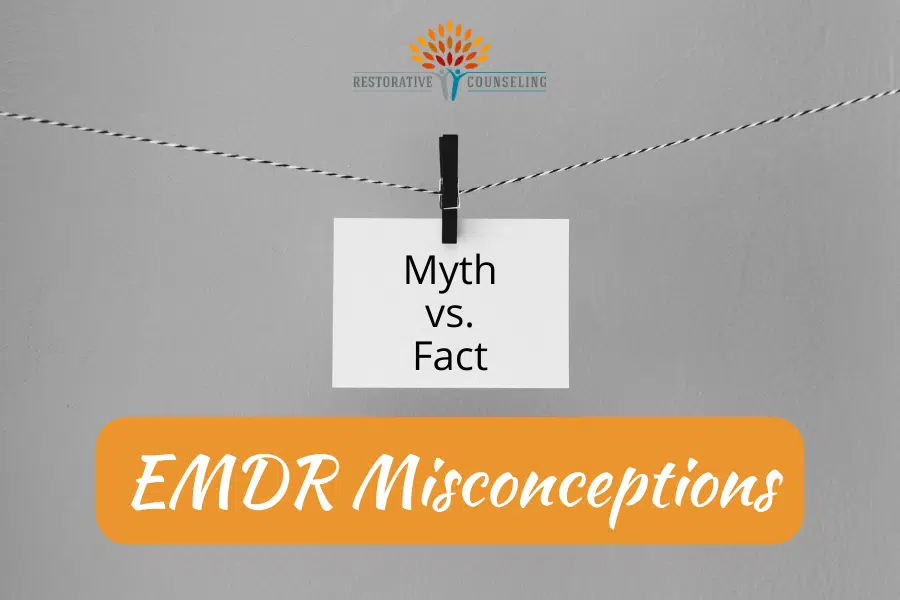Written by Jordan Meehan, LCSW
The process of healing from trauma is often intimidating, but therapy approaches such as Eye Movement Desensitization and Reprocessing (EMDR) can be highly effective. Many misconceptions about EMDR exist, but most are based on a lack of information and understanding on how this treatment works. While there is never a guarantee on how effective EMDR may be for an individual, the myths surrounding EMDR have the potential to deter a person from even trying this technique to begin with. It’s important to know the facts about EMDR so that you feel comfortable in taking the step to start EMDR treatment.
What is EMDR?
EMDR is a safe and effective therapeutic approach for treating a wide range of difficulties including Post-Traumatic Stress Disorder (PTSD), anxiety, depression, grief, and other trauma-related difficulties. This therapeutic approach gives you the opportunity to reprocess distressing memories so that you no longer feel “stuck” in your feelings or overwhelmed by your thoughts. Regardless of if you prefer in-person or virtual therapy, EMDR can be effective in helping you heal from your difficult experiences.
Heal from traumatic experiences using EMDR
Common EMDR Misconceptions
Since EMDR is not like traditional talk therapy, it can be challenging to know what to believe and not believe about this psychotherapy. Here, you can learn what is a myth and what is factual about this effective treatment. Some common EMDR misconceptions include:
Myth: EMDR works for everyone.
Fact: While EMDR has the potential to help people overcome many different mental health challenges, it is not effective or appropriate for everyone. Part of the EMDR process includes an assessment to determine if EMDR will be the right treatment approach for you. EMDR will not be beneficial for an individual who is actively abusing substances, as this diminishes the impact EMDR has on how the brain reprocesses memories. Additionally, this approach may not work well for the person who is looking for a “quick fix” or is not fully committed to “doing the work” just yet. For virtual EMDR specifically, individuals who experience a high degree of dissociation would need to seek EMDR treatment in-person.
Myth: I don’t have PTSD, therefore EMDR will not work for me.
Fact: You don’t have to be diagnosed with PTSD to reap the benefits of EMDR. This therapeutic approach helps the brain reprocess traumatic memories, and not all traumatic experiences result in PTSD. For example, an individual may initially be psychologically functional and healthy. However, after a life-threatening car accident, they may develop anxiety about riding in cars. EMDR can help this person overcome the distress caused by their traumatic experience so they can comfortably ride in cars again without feeling anxious.
Myth: EMDR will make me forget my trauma.
Fact: The goal of EMDR is to help you reprocess traumatic memories so you no longer have to “relive” those memories. EMDR will not cause you to forget your experiences. You might think about them less, but when you do remember your traumas, you will no longer be subjected to the distressing thoughts, feelings, or reactions associated with the memories.
Myth: EMDR won’t work for me because I don’t remember much about my trauma.
Fact: You don’t have to remember specific details about a traumatic experience in order to benefit from EMDR treatment. In fact, some components of memories cannot be remembered and described using language. This makes EMDR very effective for those people who struggle to have the words to describe their experiences. Traumatic memories are sometimes stored in the body and brain in ways that are outside of one’s conscious awareness. EMDR has the power to tap into how these memories are stored so that they can be fully reprocessed.
Myth: EMDR is just like hypnosis.
Fact: The goals of EMDR are very different from hypnosis. During the entirety of EMDR, you are fully present and aware of what is going on, unlike with hypnosis. EMDR allows your brain to rework how a memory is stored in your brain and body. Hypnosis may focus more on creating psychological barriers to limit your brain’s access to a traumatic memory.
Myth: EMDR is dangerous and will make my symptoms worse.
Fact: This is one of the more common EMDR misconceptions. EMDR is a safe way for you to work through your trauma. The EMDR process helps you develop strategies to better tolerate the distress that is associated with your memories. While EMDR desensitization sessions may be uncomfortable in the moment, the discomfort does not linger. Some of the common side effects you may experience immediately following a desensitization include fatigue, emotional sensitivity, and changes to your dreams. These are all a typical part of the EMDR process. It’s always a good idea to rest following an EMDR desensitization session.
Myth: EMDR can create false memories.
Fact: EMDR helps you reprocess only what already exists in your memories. This treatment method is not intended to verify the accuracy of a memory or experience. Memories are already inaccurate and change over time. EMDR is completely dependent on your experience of a memory NOW. The goal of EMDR is to help you rework old information and find adaptive ways to gain a sense of safety in relation to your traumatic memories.
Myth: I will have to talk about every detail of my trauma.
Fact: EMDR does not require you to talk about the extensive details of your trauma. You only need a few details about a memory to help you focus on it during the desensitization process. Your brain and body will do the rest of the work! Since the goal of EMDR is to reduce the distress associated with your traumatic memories, the outcomes of EMDR are not determined by how much or how little you share.
Myth: I will start EMDR desensitization sessions immediately when I start therapy.
Fact: EMDR is broken down into 8 phases. You will not begin desensitization sessions until phase 4, which typically begins around your 4th or 5th appointment. Phases 1-3 focus on assessment and development of coping strategies that you will utilize throughout the EMDR process. These skills will help build your tolerance for experiencing discomfort during the EMDR desensitization sessions. Additionally, your clinician may determine that you require a different type of therapy before you are ready for EMDR. Every individual is unique in their needs, so the timeline for starting desensitization sessions will vary from person to person.
Clearly, there are many misconceptions about EMDR and how it works. By learning what is a myth and what is factual, you can better assess if EMDR is right for you.
Don’t let EMDR misconceptions keep you from healing from life’s greatest difficulties. Restorative Counseling is here to assist you on that journey.
You are in control of your own healing. It’s important that you feel educated about how EMDR can help you work through your traumatic experiences. If you are curious to learn more or if you are ready to heal from your trauma using EMDR, schedule an appointment today.

Hi, I’m Jordan!
I partner with teens and adults to treat concerns related to trauma, anxiety, and relationships utilizing CBT, ACT, and EMDR approaches. Read more about me.
Follow Restorative Counseling
Sign up for our newsletter

